
Birding Trip to Jamaica -- January 2012
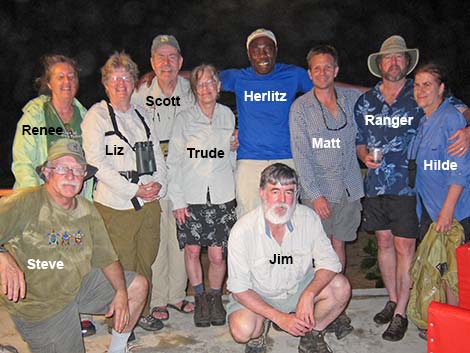 The Group (Herlitz [center], Matt [to his left]) |
During January, Liz and I traveled to Jamaica with the Alumni Association from our undergraduate Alma Matter: Humboldt State University. The trip was led by the head of the Wildlife Department, Matt Johnson. Matt has been conducting research on the birds of Jamaica for the last 15 years. Our co-leader was Herlitz Davis, a native of Jamaica, who currently is a Research Associate at the Smithsonian Institution in Washington, D.C., and is finishing his Ph.D. in Avian Ecology. Herlitz has been studying the birds of Jamaica since he was a boy with a slingshot, did his Masters research on the endemic parrots of Jamaica, and has an uncanny ability to find rare birds. Also on the trip were three other couples from the States, mostly graduates from the Humboldt State Wildlife Department. Map of the trip. |
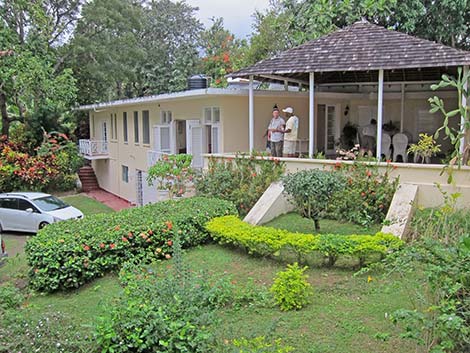 Green Castle Estate |
January 07. Miami to Jamaica. Arrive Montego Bay, drive to Annotto Bay. We had a pleasantly uneventful flight from Miami to Montego Bay. After negotiating customs and immigration, we were met by Herlitz at the airport. We met another couple and Matt there, then met the rest of the group at Sugar Mill B&B. They were off eating lunch, so we had a chance to bird the yard and were thrilled by Loggerhead Kingbirds (very common and seen everywhere), Vervain Hummingbirds (among the smallest hummingbirds), Red-billed Streamertails (hummingbirds with extreme tail feathers), Orange-faced Grassquits, and other amazing birds. From Sugar Mill, we headed east along the North Shore Highway, arriving at Green Castle Estate in time to relax for a few minutes before dinner. After dark, we set out to find a Northern Potoo, but we found one in the tree adjacent to the front porch, so we canceled the hike and played with frogs and toads in the yard. (more photos) |
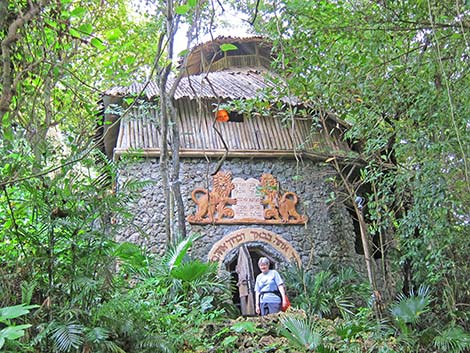 Queen of Sheba cottage at Great Huts Eco-Resort |
January 08. Annotto Bay to Boston Bay. We got up early and hiked the grounds of Green Castle Estate, finding birds such as White-crowned Pigeons, Olive-throated Parakeets, Jamaican Mangos, Jamaican Woodpeckers, and Greater Antillean Grackles. From Green Castle, we drove farther east to Boston Bay and stopped at the Great Huts Eco-Resort, an odd place celebrating the African ancestry of most Jamaicans. In the afternoon and evening, we wandered about the area overlooking the ocean from atop the cliffs and wandering along the sandy shore. (more photos) |
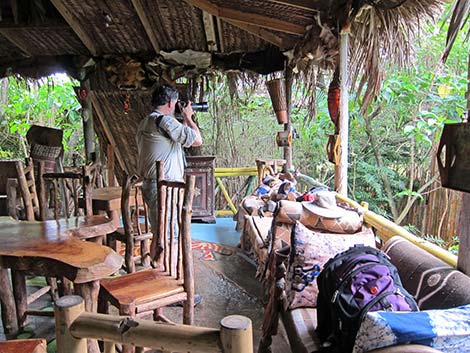 Birding from the dining room at Great Huts |
January 09. Boston Bay. We got up in the dark and hit the road heading for the John Crow Mountains. We arrived at dawn, just as the White-throated Thrushes began calling. We walked the old road, finding birds such as Jamaican Blackbirds (the rarest of the endemic species), Jamaican Orioles, Jamaican Crows, Arrow-headed Warblers, Black-billed Parrots, and Yellow-billed Parrots. In the afternoon, we drove to a different part of the John Crow Mountains and visited Riech Falls. Some of us swam in the falls, while others found Jamaican Todys, Rufous-tailed Flycatchers, Black-billed Streamertails, Orangequits, and a Louisiana Waterthrush. (more photos) |
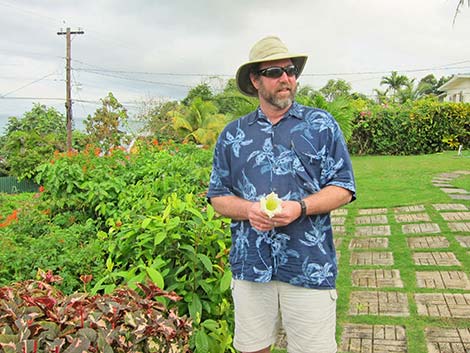 Pat (aka Ranger) at Windjammer House in Duncans |
January 10. Boston Bay to Duncans.
In the morning, we again got up in the dark and headed into the mountains. Arriving at dawn, we hiked a trail into Blue and John Crow Mountains National Park just far enough to not run away when we got a drenching rain-forest downpour. Even with raincoats, most of us were wet by the time it finished. After the storm, the early morning sunlight revealed White-eyed Thrushes, Jamaican Lizard Cuckoos, Stripe-headed Tanagers, Bananaquits, and more of the now-familiar Jamaican birds. In the afternoon, we drove back west to Duncans, where we stayed in a very nice house. Before dinner, we wandered the neighborhood, finding trees filled with warblers, Zenaida Doves, Saffron Finches, and Jamaican Euphonias. (more photos) |
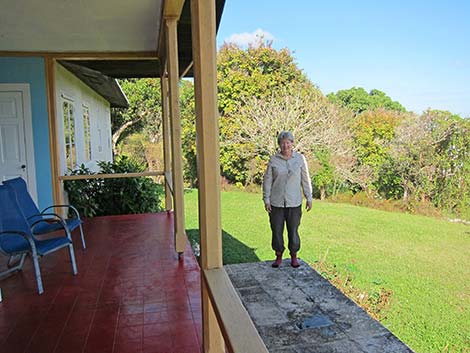 Liz on the back porch of the Copse House |
January 11. Duncans to Windsor and Copse.
Up early, we drove into the Cockpit Country at Windsor. We birded the forest and a coffee plantation where Matt's students were catching birds. We saw a Bananaquit, White-throated Thrush, Yellow-shouldered Grassquit, and Ovenbird in the hand. After lunch at Windsor Research Station, we stopped briefly at the Falmouth Highway Ponds and saw herons, American Coots, Common Gallinules, and Caribbean Coots. Continuing, we drove to Montego Bay and turned south to Copse. The Copse House is at the edge of a rural area overlooking a large plantation. We birded the grounds before dinner, seeing Jamaican Peewees, Sad Flycatchers, and lots of Orangequits. Later, we headed out into the darkness and called in three Jamaican Owls. Back on the porch, we were treated to fireflies and a jungle-full of frogs. (more photos) |
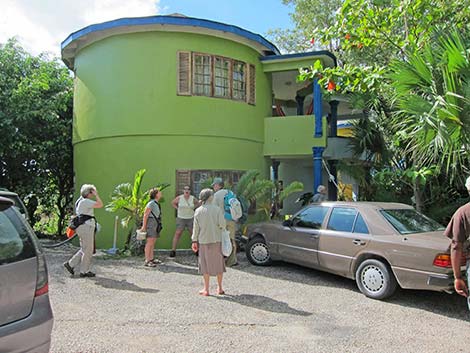 Arriving at Black River Hotel |
January 12. Copse to Black River. We birded the Copse coffee plantation in the morning, finding such species as Jamaican Lizard Cuckoos, Antillean Palm Swifts, Jamaican Becard, Jamaican Elaenia, Blue-mountain Vireos, and Cave Swallows. We even went into the mouth of the Cave Swallow's cave and saw dozens of Jamaican Fruit Bats hanging from the ceiling watching us! In the afternoon, we drove south to the coast and stayed in a hotel on the shore. We were dismayed to find that the owner kept illegal birds in cages on the property. While there, we birded the shore (Magnificent Frigatebirds, Laughing Gulls, Royal Terns) and saltwater ponds just back from the shore with Red Mangroves along the shoreline. There we saw crocodiles, Blue-winded Teal, and lots of familiar shorebird species, including Black-necked Stilts and Wilson's Plovers. (more photos) |
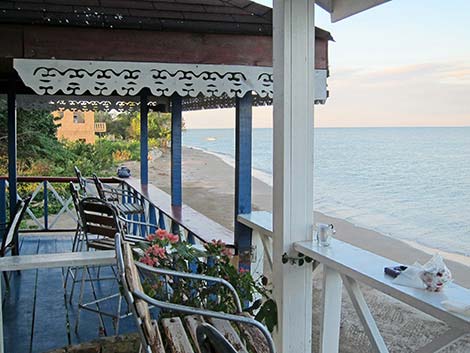 View from dining room at Black River Hotel |
January 13. Black River. After an early start, we arrived in the town of Quick Step just after sunrise and hiked out an old road used mostly by farmers and goat herders hiking into the forest. The birding was good, and we saw more lizard cuckoos, todys, Caribbean Dove, and the last of our 28 endemic species: Ring-tailed Pigeon. At mid-day, we toured the Appleton Rum Factory. It was an interesting place that produces huge amounts of alcohol. The grounds had interesting birds, lizards, and beetles. In the afternoon, we birded the Upper Black River Morass, an area of freshwater ponds and marshes where we saw West Indian Whistling Ducks, Least Bittern, Sora Rails, Purple Gallinules, Limpkin, Northern Jacana, and Black-headed Munia. (more photos) |
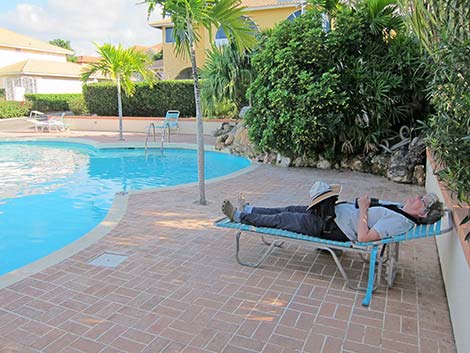 Liz relaxing at Montego Bay |
January 14. Black River to Montego Bay. We made a fairly early exit and headed for Font Hill Beach Park. We birded the Black Mangrove swamp on the edge of the developed area and saw Northern Waterthrush and lots of other warblers. At mid-day in the developed area, most of us relaxed and swam in the warm waters, but I continued birding, photographing such species at Caribbean Doves, Zenaida Doves, Common Ground Doves, Stolid Flycatchers, and others. In the afternoon, we headed north to Montego Bay in preparation for flights back to the States. After settling into a condo, I staked out a flowering tree and photographed Red-billed Streamertails, Jamaican Mango, and Vervain Hummingbirds. At night, we went downtown to see the nightlife and enjoy a nice dinner overlooking the Caribbean Sea. (more photos) |
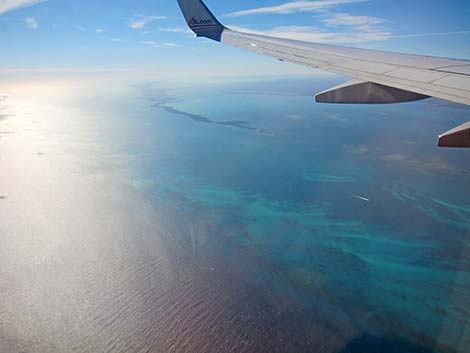 Back in US airspace: the Florida Keys |
January 15. Montego Bay to Miami. After a relaxing breakfast, Matt took Liz and me to the airport. Again we survived customs and immigration, although not intact after the Appleton gift shop, and made the gate with time to relax. The flight back to Miami was scenic and uneventful, and re-entry into the States was fast and easy. After being surrounded by so much Ganja (marijuana) smoke (not by our group), I was concerned that the drug dogs might give us trouble, but no such luck. Back on the ground, we picked up our car and headed west into Everglades National Park. We arrived at Shark Valley in time to see alligators basking on the edge of the trail (catching nothing more than the last of the evening sun) while wading birds returned to their roost for the night. The sunset was full of Wood Storks, Great Egrets, Snowy Egrets, Roseate Spoonbills, Little Blue Herons, Tricolored Heron, and White Ibis. (more photos) |
Note: All distances, elevations, and other facts are approximate.
![]() ; Last updated 240224
; Last updated 240224
| Postcards | Trip Map | Copyright, Conditions, Disclaimer | Home |